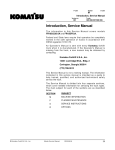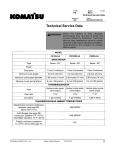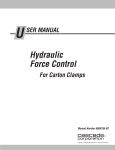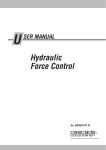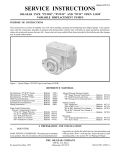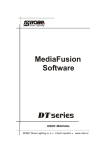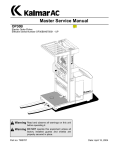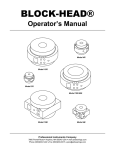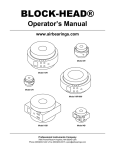Download Staging Cylinder, Three Stage Mast
Transcript
F-code Section C-code PS S6.5 6610 Staging Cylinder, Three Stage Mast Version no 001 T-code 395/396/397/398/399 Staging Cylinder, Three Stage Mast © Komatsu Forklift U.S.A., Inc. Master Service Manual 2002-01-15 473 F-code Section C-code PS S6.5 6610 Staging Cylinder, Three Stage Mast Version no T-code 001 395/396/397/398/399 1. Bearing Removal 1. Park the truck on a level surface and apply the brake. 2. Fully extend the cylinders to inspect rod (12) for gouges or pits. If gouges or pits are detected, remove cylinder for repair. ! DANGER Securely block columns to prevent lowering. If not blocked, unexpected movement could occur resulting in personal injury or death. 3. Lift mast so inner column is raised approximately 12 inches (305 mm). Securely block mast. 4. Remove bolts from top end of staging cylinder rods. Lower cylinder rods hydraulically. 5. Turn key switch to OFF and disconnect battery connector from the truck. ! WARNING Compressed air used for cleaning MUST be reduced to less than 30 psi (205 kPa) and then only with effective chip guarding and personal protective equipment. 6. Clean the exterior of the lift cylinder. 474 Master Service Manual 2002-01-15 F-code Section C-code PS S6.5 5000 Staging Cylinder, Three Stage Mast Version no 001 T-code 395/396/397/398/399 2. Disassembly 1. Remove bearing (14) from the cylinder tube. 2. Remove and discard rod wiper (16), seal (15), wear ring (9) and O ring (13) from the bearing (14). Discard seal (15). Use care NOT to damage the inside of the bearing. 3. Assembly 1. Install new bearing (14), seal (15), wear ring (9), O ring (13) and rod wiper (16). 2. The “lip” of the wiper must face outward. 3. It is not necessary to replace wear ring (9), unless the cylinder was removed for rod repair. 4. Installation 1. Install bearing in the cylinder tube. 2. Raise cylinder rods hydraulically. 3. Install bolts in the top end of the staging cylinder. 4. Connect battery connector to the truck. 5. Test for proper operation. © Komatsu Forklift U.S.A., Inc. Master Service Manual 2002-01-15 475 F-code Section C-code PS S6.6 6620 Freelift Cylinder, Three Stage Mast Version no 001 T-code 395/396/397/398/399 Freelift Cylinder, Three Stage Mast © Komatsu Forklift U.S.A., Inc. Master Service Manual 2000-08-04 477 F-code Section C-code PS S6.6 6620 Freelift Cylinder, Three Stage Mast Version no T-code 001 395/396/397/398/399 The lift cylinders are the positive displacement type, meaning there are NO seals on the lower end of the cylinder rod. The lift cylinder can be resealed without removing from the truck. NOTE! 478 CLEANLINESS! Perform procedures in a clean environment. Make sure all parts are cleaned before disassembly and kept clean during assembly. Master Service Manual 2000-08-04 F-code Section C-code PS S6.6 6620 Freelift Cylinder, Three Stage Mast Version no 001 T-code 395/396/397/398/399 1. Removal 1. Park the truck on a level surface and apply the brake. 2. Fully extend cylinder to inspect rod (9) for gouges or pits. If gouges or pits are detected, cylinder must be removed for repair. ! DANGER Securely block columns to prevent lowering. If not blocked, unexpected movement could occur resulting in personal injury or death. 3. Lift carriage/reach and securely block. 4. Lower cylinder so chains, hoses, and electric cables are loose. 5. Turn key switch to OFF and disconnect battery connector from the truck. 6. Remove chains, hoses, and electric cables from the crosshead. 7. Remove crosshead from cylinder rod. ! WARNING Compressed air used for cleaning MUST be reduced to less than 30 psi (205 kPa) and then only with effective chip guarding and personal protective equipment. 8. Clean the exterior of the lift cylinder. © Komatsu Forklift U.S.A., Inc. Master Service Manual 2000-08-04 479 F-code Section C-code PS S6.6 6620 Freelift Cylinder, Three Stage Mast Version no T-code 001 395/396/397/398/399 2. Disassembly 1. Remove bearing (12) from the cylinder tube (3). 2. Remove and discard seal (14), back-up ring (11), O ring (10), rod wiper (15) and ring guide (13) from bearing (12). Use care NOT to damage the inside of the bearing (12). 3. Assembly 1. Install new back-up ring (11), O ring (10), seal (14) rod wiper (15) and guide ring (13). 2. The “lip” of the wiper must face outward. 4. Installation 1. Install crosshead, chains, hoses and electric cables. 2. Connect battery connector to the truck. 3. Test for proper operation. 480 Master Service Manual 2000-08-04 F-code PS Version no 002 Section C-code S6.7 6650 Reach Cylinder Assembly T-code 395/396/397 Reach Cylinder Assembly © Komatsu Forklift U.S.A., Inc. Master Service Manual 2000-08-04 481 F-code Section C-code PS S6.7 6650 Reach Cylinder Assembly Version no T-code 002 395/396/397 NOTE! 482 Items 13, 19, and 21 come as an assembly. Assembly together using Loctite 277 and let set for 24 hours to cure. Master Service Manual 2000-08-04 F-code PS Version no 002 Section C-code S6.7 6650 Reach Cylinder Assembly T-code 395/396/397 1. Removal 1. Park the truck on a level surface and apply the brake. 2. Extend the reach about 1/2-3/4 of the total reach. 3. Block and chain the reach mechanism to prevent movement of the reach mechanism. 4. Relieve pressure on the reach cylinders. 5. Remove hoses from the reach cylinder. 6. Remove roll pins (3). Remove front mounting pins (4). 7. Raise reach assembly above full freelift. Remove roll pins (3). Remove rear cylinder mounting pins (5). 8. Remove reach cylinder from truck. 9. Turn key switch to OFF. Disconnect battery connector from the truck. © Komatsu Forklift U.S.A., Inc. Master Service Manual 2000-08-04 483 F-code Section C-code PS S6.7 6650 Reach Cylinder Assembly Version no T-code 002 395/396/397 2. Disassembly ! WARNING Compressed air used for cleaning MUST be reduced to less than 30 psi (206 kPa), and then only with effective chip-guarding and personal protective equipment. NOTE! CLEANLINESS! Perform procedures in a clean environment. Make sure all parts are cleaned before disassembly and kept clean during assembly. 1. Before disassembly, clean exterior of the reach cylinder in a cleaning solution to remove all contamination. 2. Be sure all hydraulic fluid has been removed from the cylinder. Stroking the piston rod will help force fluid out. 3. Put base end of cylinder in a vise equipped with soft jaws. 4. Remove bearing retainer (22) and bearing (9) by rotating bearing with a spanner wrench from cylinder tube (23 or 24). 5. Remove bearing assembly, seal (11), rings (8) and (17), and cylinder assembly consisting of the rod (13), piston (19) and lock nut (21). Discard seal (11). 6. Remove and discard rod wiper (12). 7. Inspect mounting bearing (25) located at base end of the cylinders. Do not remove bearing unless found to be unfit for further service. 484 Master Service Manual 2000-08-04 F-code PS Version no 002 Section C-code S6.7 6650 Reach Cylinder Assembly T-code 395/396/397 3. Inspection ! WARNING Compressed air used for cleaning MUST be reduced to less than 30 psi (206 kPa), and then only with effective chip-guarding and personal protective equipment. 1. Carefully clean all parts in a cleaning solution and position them on a clean work surface. 2. Check piston rod for damage. Look for gouges, scratches, corrosion, or evidence of unusual wear. Minor surface damage can be repaired by use of fine abrasion cloth or stoning. Be extremely careful to not remove chrome plating. Deeper damage will require replacement of rod assembly. Make sure the threads on the rod are free of damage. 3. Check cylinder bore for any damage. Parts with deep gouges or pitted surfaces will require replacement. 4. Check threaded section of cylinder tube to be sure threads have not been damaged. © Komatsu Forklift U.S.A., Inc. Master Service Manual 2000-08-04 485 F-code Section C-code PS S6.7 6650 Reach Cylinder Assembly Version no T-code 002 395/396/397 4. Assembly 1. Install new O ring (7), back-up ring (8), ring guide (10), seal (11), and rod wiper (12) in bearing assembly (9). The “lip” of the wiper must face outward. 2. Install new ring guide (20), back-up rings (17) and (8) on piston (19). 3. Apply clean hydraulic fluid to rod cylinder (13). Coat inside of cylinder tube and bearing assembly with clean fluid. 4. Carefully slide spacer (16) (if used) and bearing assembly (9) onto cylinder rod. Be sure rod end does not cut or nick wiper upon installation. 5. Install cylinder assembly consisting of the rod (13), piston (19) and lock nut (21) into cylinder tube (23 or 24). Be careful not to nick or cut piston seals on the edge of cylinder tube or when sliding over groove within tube. Torque cylinder piston lock nut (21) to 47.94 ft-lb (65 N•m). 6. Install bearing assembly into cylinder tube. Use care not to nick or cut seals upon installation. 7. Install retainer (22). 8. Check installation by making sure piston rod assembly moves smoothly within tube assembly without binding. 9. Install bearing (25). 486 Master Service Manual 2000-08-04 F-code PS Section C-code S6.7 6650 Reach Cylinder Assembly Version no 002 T-code 395/396/397 5. Installation 1. Connect battery connector to the truck. Turn key switch to ON. 2. Raise reach to full freelift height. Install reach cylinder rear cylinder mounting pins (5). Secure mounting pins with roll pins (3). 3. Lower reach assembly. Install reach cylinder front mounting pins (4). Secure mounting pins with roll pins (3). 4. Connect correct hydraulic hoses to reach cylinders. 5. Remove blocking and chains. 6. Fill hydraulic reservoir with new clean oil. 7. Operate reach to remove air from hydraulic hoses and check operation of the whole hydraulic system. ! CAUTION DO NOT use your hands to check for hydraulic leakage. Use a piece of cardboard or paper to search for leaks. Escaping fluid under pressure can penetrate the skin causing injury. Relieve pressure before disconnecting hydraulic or other lines. Tighten all connections before applying pressure. Keep hands and body away from pinholes and nozzles which eject fluids under high pressure. 8. After running the hydraulic system, check and fill hydraulic reservoir with new clean oil. © Komatsu Forklift U.S.A., Inc. Master Service Manual 2000-08-04 487 F-code Section C-code PS S6.8 6660 Tilt Cylinder Assembly, FR18S-2A Version no 002 T-code 395/398/399 Tilt Cylinder Assembly, FR18S-2A © Komatsu Forklift U.S.A., Inc. Master Service Manual 2000-08-04 489 F-code Section C-code PS S6.8 6660 Tilt Cylinder Assembly, FR18S-2A Version no T-code 002 395/398/399 1. Removal 1. Park the truck on a level surface and apply the brake. 2. Raise reach approximately 12 inches (305 mm) and block so reach will not lower. 3. Pivot carriage upward and block to prevent carriage/reach from lowering. 4. Turn key switch to OFF. Disconnect battery connector from the truck. 5. Relieve pressure on tilt cylinder assembly (1). 6. Remove retainer (3) and cap screws (4) securing cylinder to carriage/reach. 7. Remove hydraulic hoses from tilt cylinder assembly (1). 8. Remove tilt cylinder assembly (1) from the truck. 490 Master Service Manual 2000-08-04 F-code Section C-code PS S6.8 6660 Tilt Cylinder Assembly, FR18S-2A Version no 002 T-code 395/398/399 2. Disassembly ! WARNING NOTE! Compressed air used for cleaning MUST be reduced to less than 30 psi (206 kPa), and then only with effective chip-guarding and personal protective equipment. Perform procedures in a clean environment. Make sure all parts are cleaned before disassembly and kept clean during assembly. 1. Before disassembly, clean exterior of tilt cylinder (1) in a cleaning solution to remove all contamination. 2. Be sure all hydraulic fluid has been removed from cylinder. Stroking piston rod will help force fluid out. 3. Put trunnion of cylinder in a vise equipped with soft jaws. 4. Remove bearing retainer (13) from cylinder tube. 5. Remove bearing assembly, seal (6), back-up ring (8), cylinder rod (10) and piston seals. 6. Remove and discard all seals (6), O rings (9 and 11), back-up rings (8 and 12) and rod wiper (5). 7. Inspect mounting bushings (2) located at both ends of cylinder. Do not remove bushings unless found to be unfit for further service. © Komatsu Forklift U.S.A., Inc. Master Service Manual 2000-08-04 491 F-code Section C-code PS S6.8 6660 Tilt Cylinder Assembly, FR18S-2A Version no T-code 002 395/398/399 3. Inspection ! WARNING Compressed air used for cleaning MUST be reduced to less than 30 psi (206 kPa), and then only with effective chip-guarding and personal protective equipment. 1. Carefully clean all parts in a cleaning solution and position on a clean work surface 2. Check cylinder rod (10) for damage. Look for gouges, scratches, corrosion, or evidence of unusual wear. Minor surface damage can be repaired by the use of fine abrasion cloth or stoning. Be extremely careful not to remove the chrome plating. Deeper damage will require replacement of piston rod assembly. Make sure threads on rod are free of damage. 3. Check cylinder bore for any damage. Parts with deep gouges or pitted surfaces will require replacement. 4. Check threaded section of cylinder tube to be sure threads have not been damaged. 492 Master Service Manual 2000-08-04 F-code Section C-code PS S6.8 6660 Tilt Cylinder Assembly, FR18S-2A Version no 002 T-code 395/398/399 4. Assembly 1. Install new seals (6), O ring (9), backup ring (8), and rod wiper (5) in bearing assembly. The “lip” of the wiper must face outward. 2. Install new O ring (11) and back-up ring (12) on cylinder rod (10). 3. Apply clean hydraulic fluid to cylinder rod assembly. Coat the inside of the cylinder barrel and bearing assembly with clean fluid. 4. Carefully slide bearing assembly on cylinder rod. Be sure rod end does not cut or nick wiper (5) and seal (6) upon installation. 5. Install rod into cylinder barrel. Be careful not to nick or cut piston seals on the edge of cylinder barrel or when sliding over groove within barrel. 6. Install bearing assembly into cylinder barrel. Use care not to nick or cut seals upon installation. 7. Check installation by making sure cylinder rod assembly moves fairly easy within barrel assembly without binding. 8. Install bearing fastening ring and retainer. © Komatsu Forklift U.S.A., Inc. Master Service Manual 2000-08-04 493 F-code Section C-code PS S6.8 6660 Tilt Cylinder Assembly, FR18S-2A Version no T-code 002 395/398/399 5. Installation 1. Install cylinder on reach front frame. 2. Install retainer (3) and secure with four cap screws (4). 3. Properly connect correct hydraulic hoses to front and rear of tilt cylinder. 4. Remove blocking and chains. 5. Fill hydraulic reservoir with new clean oil. 6. Connect battery connector to the truck. ! WARNING DO NOT use your hands to check for hydraulic leakage. Use a piece of cardboard or paper to search for leaks. Escaping fluid under pressure can penetrate the skin causing injury. Relieve pressure before disconnecting hydraulic or other lines. Tighten all connections before applying pressure. Keep hands and body away from pinholes and nozzles which eject fluids under high pressure. 7. Operate tilt to remove air from hydraulic hoses and check operation of whole hydraulic system. 8. After running the hydraulic system, check and fill hydraulic reservoir with more new clean oil. 494 Master Service Manual 2000-08-04 F-code Section C-code PS S6.9 6660 Tilt Cylinder Assembly, FR23S-2A/FR15DR-2A Version no 001 Tilt Cylinder Assembly, © Komatsu Forklift U.S.A., Inc. Master Service Manual 2000-08-04 T-code 396/397 FR23S-2A/FR15DR-2A 495 F-code Section C-code PS S6.9 6660 Tilt Cylinder Assembly, FR23S-2A/FR15DR-2A Version no T-code 001 396/397 496 Master Service Manual 2000-08-04 F-code Section C-code PS S6.9 6660 Tilt Cylinder Assembly, FR23S-2A/FR15DR-2A Version no 001 T-code 396/397 1. Removal 1. Park the truck on a level surface and apply the brake. 2. Raise reach approximately 12 inches (304 mm) and block so reach will not lower. 3. Pivot carriage upward and block to prevent carriage/reach from lowering. 4. Turn key switch to OFF and disconnect battery connector from the truck. 5. Relieve pressure on tilt cylinder. 6. Remove hydraulic hoses from tilt cylinder and mark their position. 7. Remove roll pin (6) and top mounting pin (5). Remove tilt cylinder from truck. 8. Repeat procedure on other side of truck as needed. © Komatsu Forklift U.S.A., Inc. Master Service Manual 2000-08-04 497 F-code Section C-code PS S6.9 6660 Tilt Cylinder Assembly, FR23S-2A/FR15DR-2A Version no T-code 001 396/397 2. Disassembly ! WARNING NOTE! Compressed air used for cleaning MUST be reduced to less than 30 psi (206 kPa), and then only with effective chip-guarding and personal protective equipment. CLEANLINESS! Perform procedures in a clean environment. Make sure all parts are cleaned before disassembly and kept clean during assembly. 1. Before disassembly, clean exterior of tilt cylinder in a cleaning solution to remove all contamination. 2. Be sure all hydraulic fluid has been removed from cylinder. Stroking the piston rod will help force fluid out. 3. Put base end of cylinder in a vise equipped with soft jaws. 4. If necessary, remove roller bearing (3) at base of cylinder rod (24). Remove roll pin (1) and slide mounting pin (4) from clevis (26). 5. Remove retainer (10) by rotating gland with a spanner wrench from cylinder tube (9). 6. Remove gland assembly, seals, rings, rod and piston, and piston seals. 7. Remove and discard all seals and rod wiper (23). 8. Inspect mounting bearing (8) located at base end of cylinder tube (9). Do not remove bearing unless found to be unfit for further service. 498 Master Service Manual 2000-08-04 F-code Section C-code PS S6.9 6660 Tilt Cylinder Assembly, FR23S-2A/FR15DR-2A Version no 001 T-code 396/397 3. Inspection ! WARNING Compressed air used for cleaning MUST be reduced to less than 30 psi (206 kPa), and then only with effective chip-guarding and personal protective equipment. 1. Carefully clean all parts in a cleaning solution and position on a clean work surface 2. Check piston rod (24) for damage. Look for gouges, scratches, corrosion or evidence of unusual wear. Minor surface damage can be repaired by use of fine abrasion cloth or stoning. Be extremely careful not to remove the chrome plating. Deeper damage will require replacement of piston rod assembly. Make sure threads on rod are free of damage. 3. Check cylinder bore for any damage. Parts with deep gouges or pitted surfaces will require replacement. 4 © Komatsu Forklift U.S.A., Inc. Check threaded section of cylinder tube (9) to be sure threads have not been damaged. Master Service Manual 2000-08-04 499 F-code Section C-code PS S6.9 6660 Tilt Cylinder Assembly, FR23S-2A/FR15DR-2A Version no T-code 001 396/397 4. Assembly 1. Install new guide ring (21), seal (22) and rod wiper (23) in gland assembly. The “lip” of the wiper must face outward. 2. Install new piston seals (15) and (17), guide ring (13), and sealing ring (16) on piston (14). 3. Install piston (14) on rod (24). 4. Install nut (11) on cylinder rod (24). Torque cylinder piston nut to 60-65 ft-lb (81-88 N•m). 5. Apply clean hydraulic fluid to piston rod assembly. Coat inside of cylinder tube (9) and gland assembly with clean fluid. 6. Carefully slide gland assembly onto piston cylinder rod (24). Be sure rod end does not cut or nick wiper (23) and seal (22) upon installation. 7. Install piston and rod into cylinder tube (9). Be careful not to nick or cut piston seals on the edge of cylinder tube or when sliding over groove within tube. 8. Install gland assembly into cylinder tube (9). Use care not to nick or cut seals are upon installation. 9. Install retainer (10). 10. Check installation by making sure piston rod assembly moves fairly easy within tube assembly without binding. 11. Install bearing (20). 12. If removed, install roller bearing and clevis assembly. 500 Master Service Manual 2000-08-04 F-code Section C-code PS S6.9 6660 Tilt Cylinder Assembly, FR23S-2A/FR15DR-2A Version no 001 T-code 396/397 5. Installation 1. Install tilt cylinder on carriage/reach front frame. Secure with mounting pin (5) with roll pin (6). 2. Properly connect correct hydraulic hoses to the top and bottom of tilt cylinder. 3. Remove blocking and chains. 4. Fill hydraulic reservoir with new clean oil. 5. Connect battery connector to the truck. 6. Operate tilt to remove air from hydraulic hoses and check operation of the whole hydraulic system. ! WARNING DO NOT use your hands to check for hydraulic leakage. Use a piece of cardboard or paper to search for leaks. Escaping fluid under pressure can penetrate the skin causing injury. Relieve pressure before disconnecting hydraulic or other lines. Tighten all connections before applying pressure. Keep hands and body away from pinholes and nozzles which eject fluids under high pressure. 7. After running the hydraulic system, check and fill hydraulic reservoir with new clean oil. © Komatsu Forklift U.S.A., Inc. Master Service Manual 2000-08-04 501



























